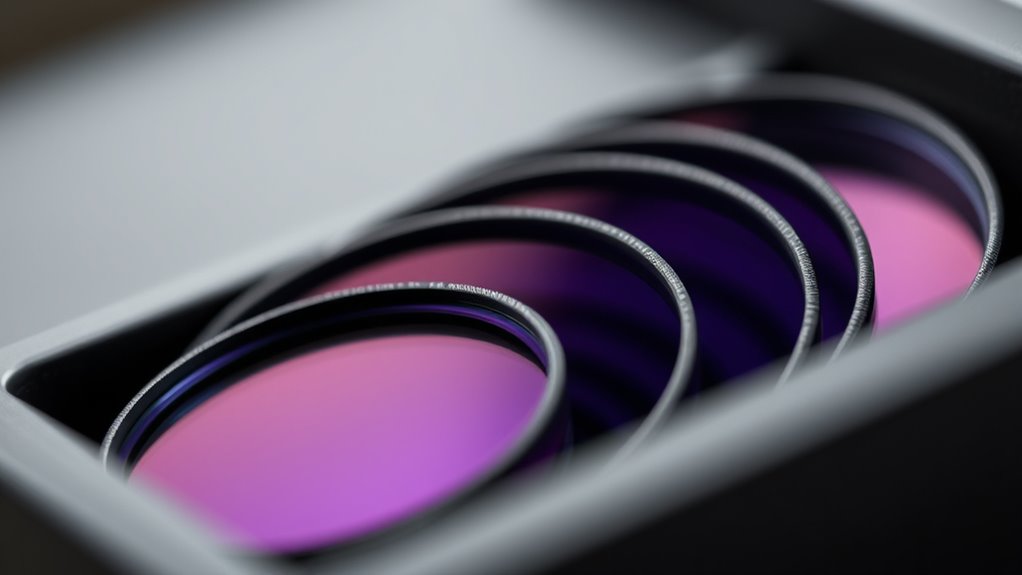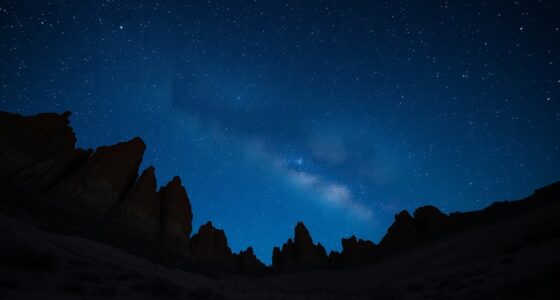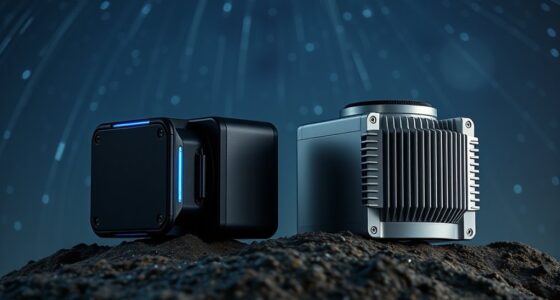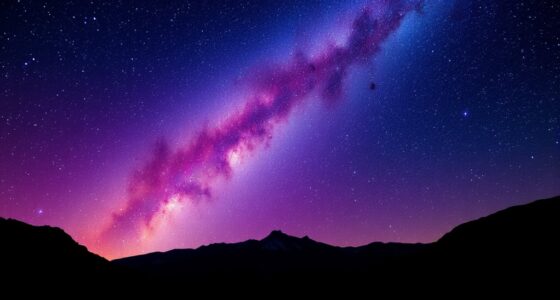If you’re looking for the best 2-inch UV/IR cut filters to improve your photos and videos, I recommend options like the SVBONY UV IR Cut Filter, Optolong UV/IR Cut Filter, and Astromania’s high-quality filters. These filters block unwanted UV and IR wavelengths, boosting clarity, contrast, and detail in your images. They’re compatible with most telescopes, cameras, and filter wheels, ensuring smooth integration. Keep going to discover more about top choices and how to select the perfect filter for your needs.
Key Takeaways
- High-quality 2-inch UV/IR cut filters with multi-coatings improve image clarity by blocking unwanted ultraviolet and infrared rays.
- Select filters with high light transmission (above 95%) to ensure bright, contrast-rich photos and videos.
- Consider reputable brands like SVBONY, Optolong, or Astromania for durable, well-coated filters with precise fitment.
- Ensure compatibility with your telescope, DSLR, or filter wheel to prevent vignetting and focus issues.
- Budget-friendly options may have minor imperfections but still significantly enhance sharpness and color accuracy.
Astromania 2 IR/UV Blocking Filter – Keeps Your Planetary Images Sharp
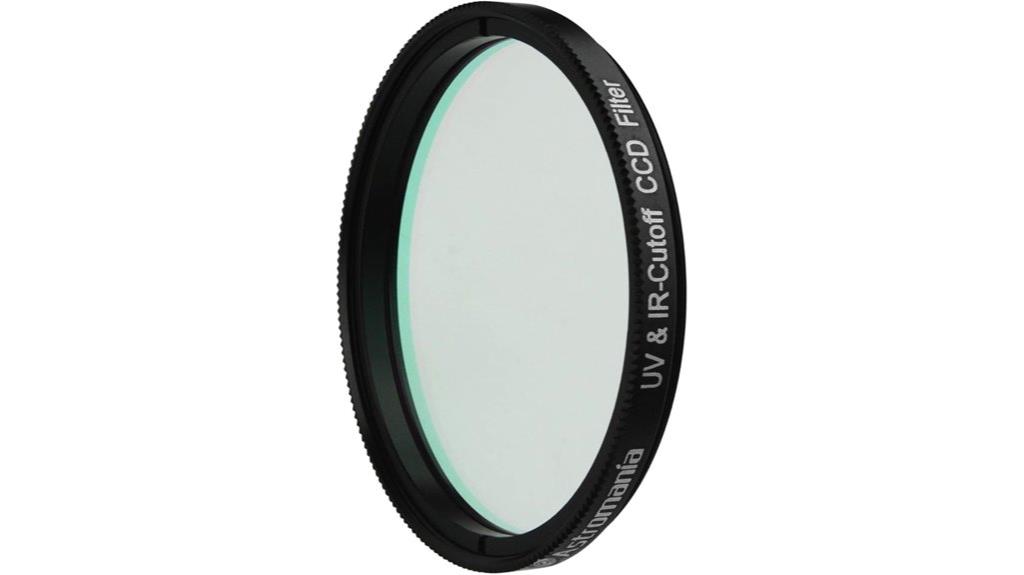
If you’re serious about planetary imaging, the Astromania 2 IR/UV Blocking Filter is a must-have tool. It blocks harmful UV and IR wavelengths, allowing only visible light (400-680nm) to reach your camera sensor. This results in sharper, more focused images by preventing out-of-focus effects caused by infrared light. The filter is optically polished and coated for high performance, housed in a durable aluminum frame. It’s especially effective with CCD cameras and webcams, providing clearer, more accurate planetary photos. Although some users note internal reflections, overall, this filter improves image clarity and safety, making it a valuable addition to your astrophotography setup.
Best For: Amateur and professional planetary astronomers seeking sharper, more accurate images with CCD cameras and webcams by blocking unwanted UV and IR light.
Pros:
- Enhances planetary image clarity by filtering harmful UV and IR wavelengths
- Durable, optically polished construction with a robust aluminum housing
- Easy to integrate with standard astrophotography equipment
Cons:
- Some users experience internal reflections causing star distortions
- Thickness (approximately 1mm glass) may affect focus with certain DSLR cameras
- Potential need for additional adjustments or accessories for optimal focus in specific setups
Astromania Narrowband NBPF Hydrogen-a 12nm Filter
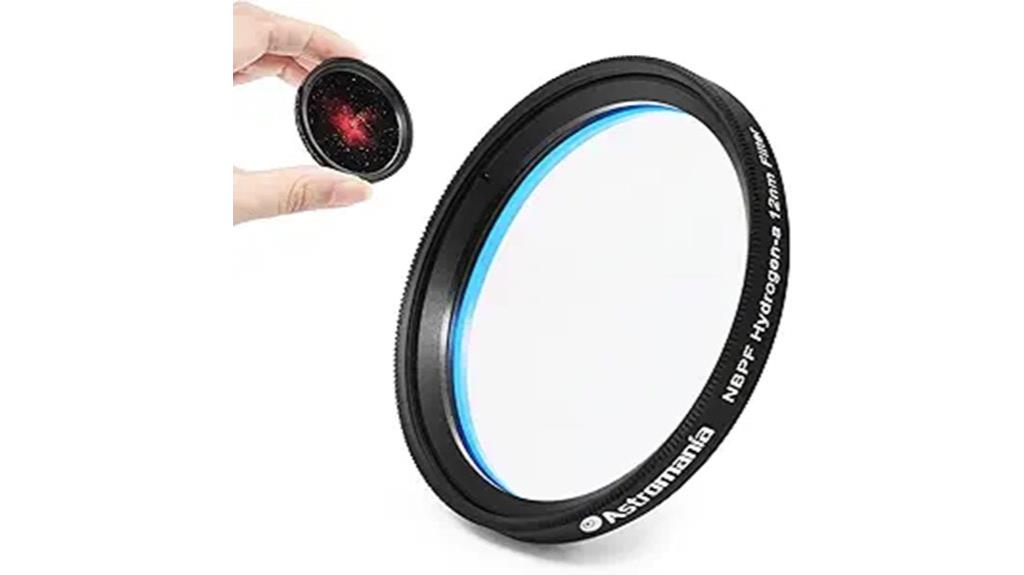
The Astromania Narrowband NBPF Hydrogen-alpha 12nm Filter is an excellent choice for amateur astrophotographers aiming to capture detailed images of hydrogen emission nebulae, especially under light-polluted skies. Its 12 nm bandwidth centered at 656 nm effectively blocks stray light from mercury and sodium vapor lamps, enhancing contrast. With about 85% transmittance at H-alpha, it highlights nebulae like M16 and the Horsehead Nebula. Designed for 2-inch eyepieces, it’s durable and easy to thread in. While it works best with modified cameras, unmodded DSLRs need longer exposures. Despite some coating durability issues, it offers great value for capturing hydrogen-rich cosmic objects.
Best For: amateur astrophotographers seeking to capture hydrogen emission nebulae under light-polluted skies, especially with modified cameras.
Pros:
- Enhances contrast of hydrogen-rich nebulae by blocking stray light from urban light pollution and lamp emissions.
- Easy to thread into 2-inch telescope eyepieces with durable anodized housing.
- Effective for capturing detailed images of nebulae like M16 and the Horsehead Nebula with relatively short exposures.
Cons:
- Coating durability issues may lead to cracking or flaking after limited use.
- Less effective with unmodified DSLRs due to IR/UV filters requiring longer exposure times.
- Slightly narrower than specified bandwidth (around 9.1 nm FWHM) and transmittance slightly below 90%, which may impact maximum brightness.
Optolong UV/IR Cut Filter – 2
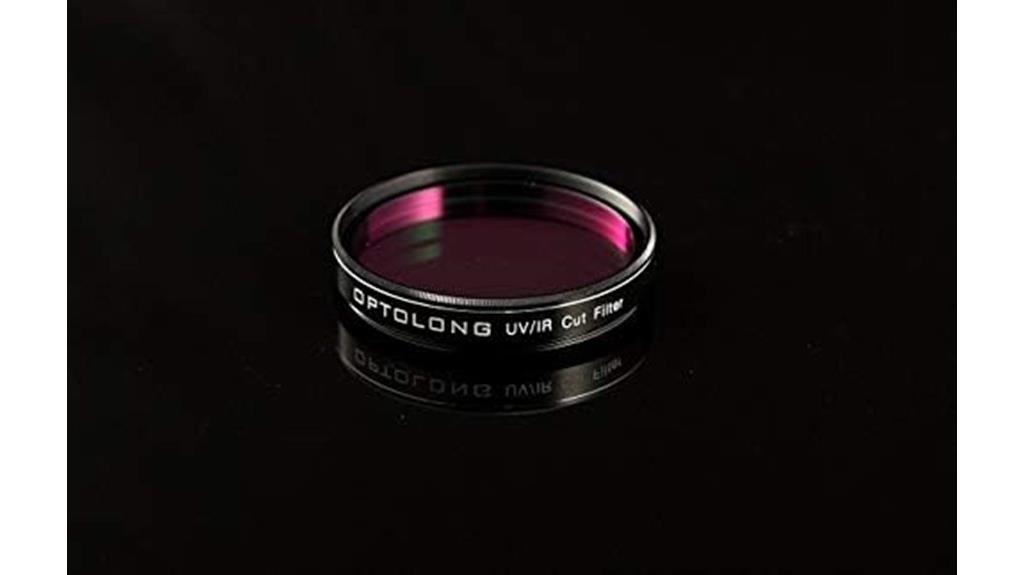
Astrophotographers seeking a reliable way to improve image sharpness will find the Optolong UV/IR Cut Filter – 2 an excellent choice, especially when working with digital cameras or modified sensors lacking built-in IR protection. This 2-inch filter blocks ultraviolet and infrared wavelengths, reducing halos and star fringing that can distort images. It’s designed for optical systems that focus primarily on the visible spectrum, ensuring sharper, clearer photos of galaxies and star clusters, even in light-polluted skies. Weighing just 1.44 ounces, it’s compatible with most setups and has earned positive reviews for its effectiveness and affordability, making it a popular choice among astrophotographers.
Best For: astrophotographers using digital cameras or modified sensors seeking to enhance image clarity by reducing UV and IR interference.
Pros:
- Effectively reduces halos and star fringing for sharper images
- Compatible with a wide range of camera setups due to its standard 2-inch size
- Affordable option that delivers noticeable improvements in astrophotography quality
Cons:
- Quality control inconsistencies may lead to scratches or defects affecting performance
- Some users report variability in filter durability over time
- Limited to blocking UV/IR wavelengths; may not suit all specialized astrophotography needs
SVBONY Telescope UV IR Cut Filter for Astrophotography (2 Inch Threads)
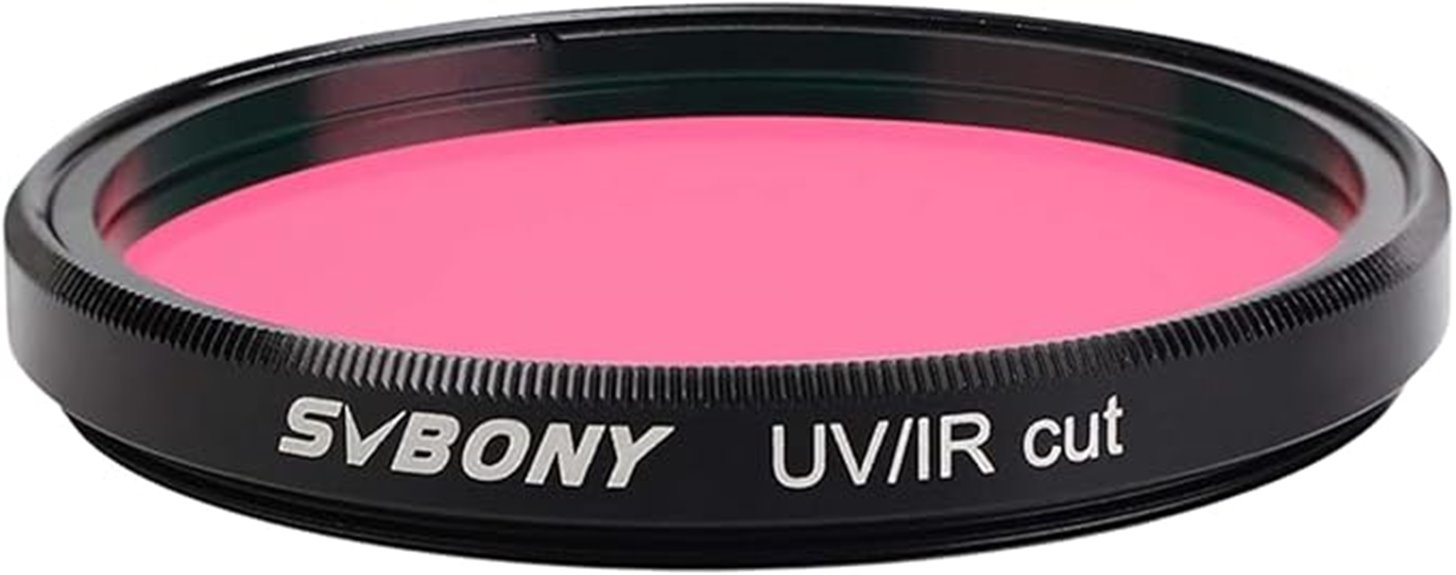
Designed with advanced multi-coating technology, the SVBONY Telescope UV IR Cut Filter is ideal for those seeking sharp, high-contrast images in astrophotography. It blocks ultraviolet and infrared rays that can distort images, ensuring better detail and natural colors. Made from true optical glass with durable coatings, it reduces chromatic aberration and ghost images. Its plane-parallel substrate and striate-free design protect your equipment while maintaining image quality. Compatible with telescopes, DSLR, CCD, and webcams, it attaches easily via standard 2-inch threads. Whether you’re capturing planets, deep-sky objects, or lunar details, this filter helps improve focus, contrast, and overall image clarity at an affordable price.
Best For: amateur astronomers and astrophotographers seeking an affordable, high-quality UV/IR cut filter to enhance image clarity and color accuracy in their astrophotography setups.
Pros:
- High-quality multi-coating technology for effective UV and IR blocking
- Compatible with various equipment including telescopes, DSLR, CCD, and webcams
- Durable, striate-free optical glass with protective lens coating and easy 2-inch threading
Cons:
- Minor surface dust or stains may be present upon receipt, requiring cleaning
- Some users may notice color gradients in images that need post-processing correction
- Slight variation in appearance or quality due to being a budget-friendly product
Astromania 2 IR/UV Blocking Filter – Keeps Your Planetary Images Sharp
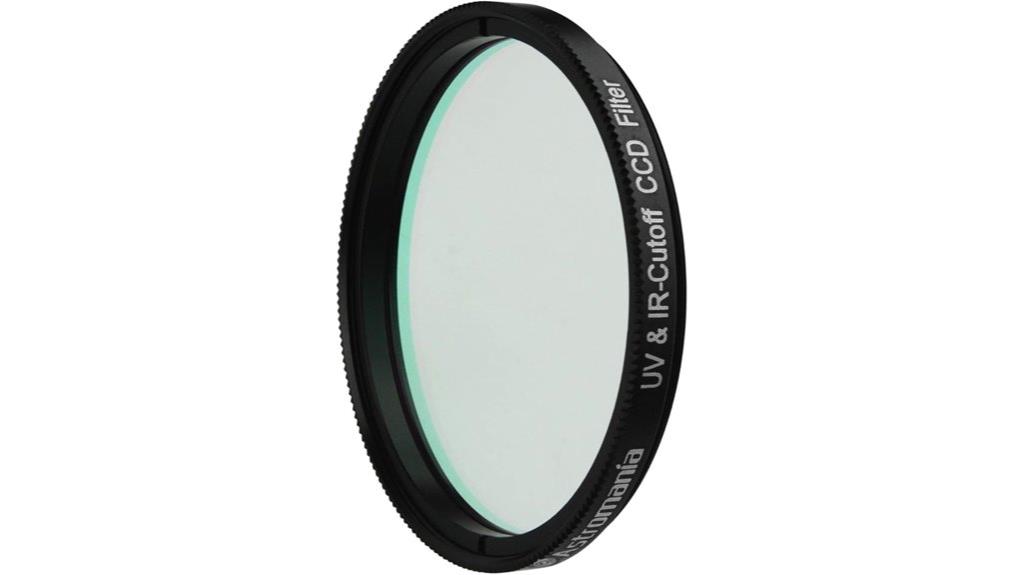
If you’re looking to capture sharp, detailed planetary images, the Astromania 2 IR/UV Blocking Filter is an excellent choice. It filters out harmful UV and IR wavelengths, allowing only visible light (400-680nm) to reach your camera sensor. This results in clearer, more focused images by eliminating out-of-focus infrared effects. Designed for CCD cameras and webcams, it’s built with high-quality optical coating and a durable aluminum housing. While some users report internal reflections or focus issues with certain setups, overall, it provides improved image clarity and safety during planetary imaging. It’s a reliable option for enhancing your celestial photographs.
Best For: amateur astronomers and astrophotographers seeking to capture sharp, detailed planetary images with their CCD cameras or webcams.
Pros:
- Enhances image sharpness by blocking IR and UV wavelengths that cause out-of-focus effects.
- Durable construction with high-quality optical coating and aluminum housing.
- Improves safety during planetary observation by filtering harmful UV rays.
Cons:
- Some users experience internal reflections that can cause star distortions.
- The filter’s thickness (~1mm glass) may affect focus in certain DSLR setups.
- Focus adjustment may be needed due to the filter’s optical properties and coating quality.
ICE 2 UV IR Cut Filter Optical Glass Multi-Coated MC for Telescope
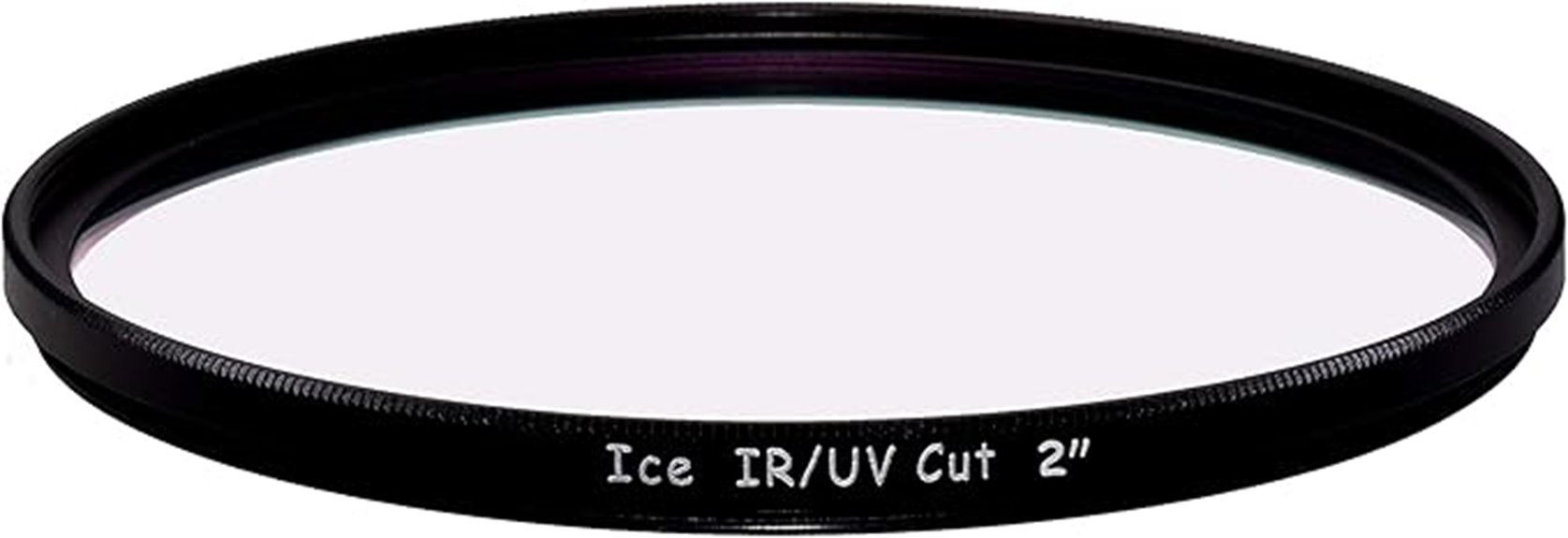
The ICE 2 UV IR Cut Filter Optical Glass Multi-Coated MC stands out as an essential accessory for telescope users seeking sharper, clearer images. It effectively blocks UV rays below 390nm and IR rays above 750nm, while transmitting 99.4% of light within the 400-700nm range. Made from high-quality optical glass with multi-coatings, it reduces atmospheric haze and enhances image clarity. Compatible with any 2-inch eyepiece telescope, including popular brands like Celestron, Orion, and Meade, this filter comes with a protective plastic case. It’s a durable, versatile tool that considerably improves visual observation and astrophotography.
Best For: Amateur and professional astronomers seeking to enhance image clarity and reduce atmospheric haze during celestial observations.
Pros:
- Effectively blocks UV and IR rays, improving image sharpness
- High light transmission (99.4%) within the visible spectrum for bright, clear views
- Compatible with a wide range of 2-inch telescope eyepieces, including major brands
Cons:
- May require careful handling to avoid scratches or fingerprints on the multi-coated glass
- Does not include additional filters or accessories beyond the protective case
- Potentially adds a slight cost increase compared to unfiltered eyepieces
Astromania 2 UHC Filter for Extended Nebulae
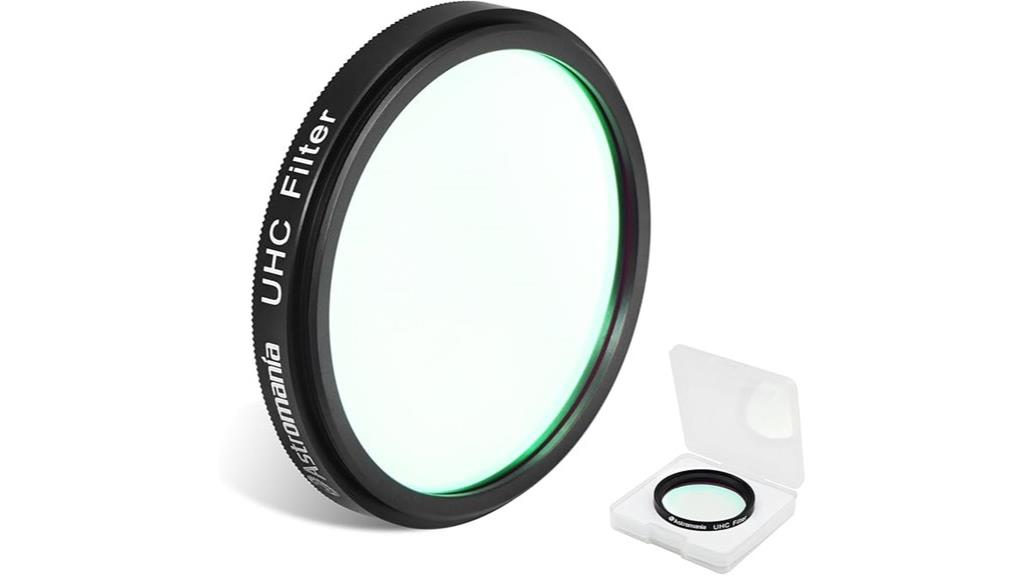
For astronomers seeking to reveal faint nebulae and enhance contrast in their observations, the Astromania 2 UHC Filter is an excellent choice. It improves contrast by blocking light pollution from mercury and sodium lamps, making details like dark lanes, wisps, and faint structures more visible. Compatible with small telescopes and featuring a 2-inch thread, it’s easy to use and durable. The filter is individually inspected and inscribed with light transmittance percentages, ensuring quality. It performs well in both dark and light-polluted skies, revealing nebulae like Orion, Lagoon, and Eagle, with minimal brightness loss to preserve natural viewing experience.
Best For: amateur astronomers seeking to improve contrast and observe faint nebulae in both dark and light-polluted skies, especially with small telescopes.
Pros:
- Enhances contrast and detail in nebulae, revealing structures like dark lanes and wisps.
- Blocks light pollution from mercury and sodium lamps, improving visibility in light-polluted areas.
- Individually inspected with light transmittance markings, ensuring quality and consistent performance.
Cons:
- Slight color tinting (pink or purple) may affect natural color perception.
- Plastic housing requires careful handling to avoid damage.
- Less effective for lunar observation and galaxy clarity, with modest brightness reduction.
Astromania 2 Luminance Filter

Astromania’s 2 Luminance Filter stands out as an excellent choice for astrophotographers seeking high-quality luminance imaging. It’s designed with a 2-inch anodized aluminum cell that threads easily into camera nosepieces or filter wheels, ensuring compatibility with most accessories. This filter belongs to the HT precision range, offering high transmission, advanced multicoatings, and scratch resistance. It effectively blocks UV and IR wavelengths, boosting contrast and clarity without distorting natural colors. Ideal for LRGB astrophotography, it helps reduce unwanted reflections and dust, enhancing star and galaxy images. Users praise its ease of use, performance, and value, making it a solid addition to any astrophotography setup.
Best For: amateur and professional astrophotographers seeking high-quality luminance filters to improve contrast, clarity, and color accuracy in their celestial images.
Pros:
- High transmission and advanced multicoatings enhance image quality and reduce reflections
- Compatible with most 2-inch astrophotography accessories for versatile use
- Effective in blocking UV and IR wavelengths, improving contrast and detail
Cons:
- Minor vignetting may occur at certain configurations or with specific accessories
- Slightly more expensive than basic filters, though justified by quality
- May require careful handling due to scratch-resistant coatings to prevent damage
SVBONY SV226 Telescope Filter Drawer Bundle

If you’re serious about high-quality astrophotography or precise digital imaging, the SVBONY SV226 Telescope Filter Drawer Bundle offers a standout solution. It features two filter holders compatible with 1.25-inch and 2-inch filters, making setup quick and easy. The double magnet system provides a stronger hold, simplifying installation and ensuring stability in dark environments. Its UV-IR-Cut filter uses advanced coatings to block UV and IR rays, resulting in sharper images with natural colors. Made from true optical glass and durable coatings, this bundle is built to last, protecting your equipment while enhancing image quality. It’s a convenient, reliable choice for serious imaging enthusiasts.
Best For: astrophotographers and digital imaging enthusiasts seeking a durable, easy-to-use filter system for high-quality observations and captures.
Pros:
- Compatible with both 1.25-inch and 2-inch filters for versatile application
- Double magnet system ensures secure, stable installation in dark environments
- Advanced UV-IR-Cut coating enhances image clarity, color accuracy, and detail
Cons:
- May require additional adapters for some telescope setups
- Slightly higher cost compared to traditional screw-in filters
- Filter drawer mechanism might be less convenient for rapid filter changes during dynamic sessions
SVBONY 2-Inch Moon Telescope Filter Bundle

The SVBONY 2-Inch Moon Telescope Filter Bundle stands out as an excellent choice for amateur astronomers seeking versatile and high-quality lunar and planetary observation tools. It includes a UV-IR Cut Block Filter that enhances image clarity by blocking ultraviolet and infrared rays, improving contrast and detail. Made with true optical glass and advanced coatings, it delivers sharp images, natural colors, and smooth gradation, reducing chromatic aberration. The filter mildly darkens the night sky, highlighting faint objects and filtering out light pollution from street lamps. Its durable design ensures long-lasting performance, making it an all-rounder option for both casual and serious astronomers.
Best For: amateur astronomers and stargazing enthusiasts seeking versatile, high-quality lunar and planetary observation tools with enhanced image clarity and light filtering capabilities.
Pros:
- Delivers sharp, detailed images with natural colors thanks to true optical glass and advanced coatings
- Effectively blocks ultraviolet and infrared rays, improving contrast and reducing chromatic aberration
- Mildly darkens the sky to enhance visibility of faint objects while reducing light pollution interference
Cons:
- May require compatible telescope adapters to fit certain models
- Slightly reduces overall brightness, which might be a concern for deep-sky object viewing
- Premium coatings and materials may come at a higher price point compared to basic filters
SVBONY UV IR Cut Block Filter with 2 inches UHC Filter
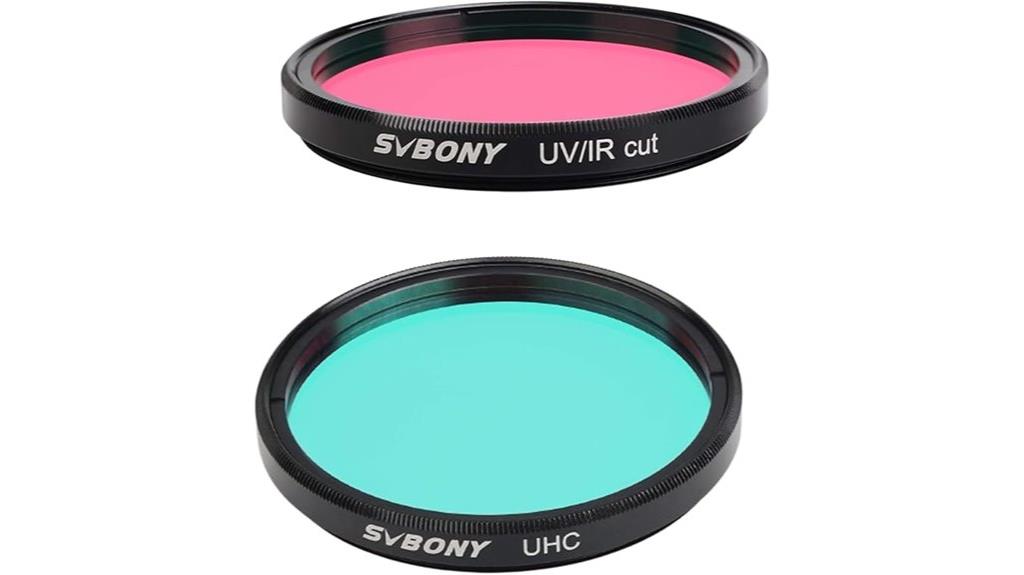
For amateur astronomers and astrophotographers seeking a reliable filter to enhance image contrast, the SVBONY UV IR Cut Block Filter with 2-inch UHC filter stands out as an excellent choice. Its optical glass lens and aluminum frame ensure durability and precise filtration. This filter effectively blocks ultraviolet and infrared rays, passing only the best light around 400nm, which improves image clarity and contrast. It’s particularly great for observing faint deep-sky objects from city or suburban locations, darkening the sky background and revealing more detail. With advanced coating technology, it delivers sharp, natural-colored images, making it a valuable addition to any astrophotography setup.
Best For: amateur astronomers and astrophotographers seeking to improve image contrast and detail in their celestial observations and astrophotography.
Pros:
- Enhances contrast by effectively blocking UV and IR rays for clearer images
- Constructed with durable optical glass and aluminum frame for long-lasting use
- Ideal for observing faint deep-sky objects from city and suburban locations
Cons:
- May cause halos at high exposure settings, requiring adjustment of exposure times
- Requires proper handling to avoid scratches or damage to the optical coatings
- Compatibility depends on the size of the telescope’s filter threading and holder
Astromania 2 Luminance Filter

Astromania’s 2 Luminance Filter stands out as an excellent choice for astrophotographers seeking high-quality imaging without distortion. This 2-inch filter features advanced multicoatings that maximize light transmission while minimizing reflections and scratches. It effectively blocks UV and IR wavelengths, notably enhancing image contrast and clarity. Designed for LRGB astrophotography, it helps keep dust off sensors and reduces unwanted reflections. Compatible with any 2-inch accessory, it maintains parfocality with other high-transmission filters. Users praise its ease of use, affordability, and ability to improve star images, making it a reliable tool for capturing detailed celestial objects.
Best For: amateur and professional astrophotographers seeking a high-quality luminance filter to improve image contrast, reduce IR interference, and maintain natural color balance in their celestial imaging.
Pros:
- High transmission with advanced multicoatings that minimize reflections and scratches
- Effectively blocks UV and IR wavelengths, enhancing image clarity and contrast
- Compatible with any 2-inch astrophotography accessories and maintains parfocality with other filters
Cons:
- Minor vignetting may occur at certain configurations or with specific accessories
- Limited to 2-inch diameter, not suitable for larger or different sized filter systems
- May require careful handling due to its thin profile and optical coating integrity
SVBONY 2-Inch UV IR Cut Telescope Filter Bundle
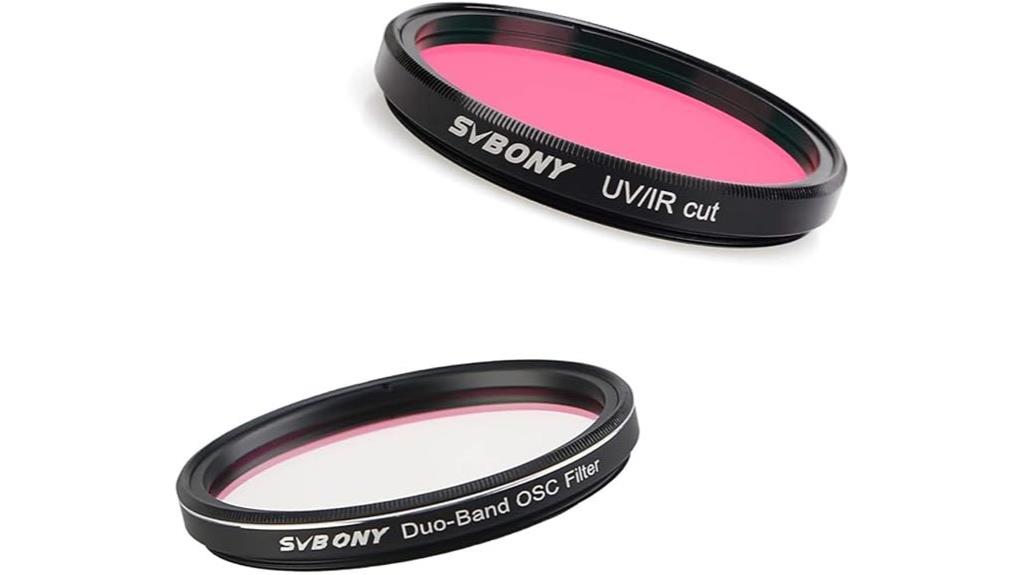
If you’re serious about capturing crisp, high-contrast astronomical images, the SVBONY 2-Inch UV IR Cut Telescope Filter Bundle is an excellent choice. It includes a UV-IR-Cut filter and a SV220 dual-band nebula filter, both built with advanced coating technology and true optical glass. These filters reduce unwanted ultraviolet and infrared light, boosting contrast and detail in your photos. They’re compatible with DSLR, CCD cameras, modified WebCams, and telescopes, serving as durable lens protectors. Whether you’re imaging planets or deep-sky objects, this bundle helps deliver sharper images with natural colors, making it a versatile addition to any astrophotography setup.
Best For: amateur and professional astronomers seeking high-quality image enhancement and contrast in astrophotography across planets, deep-sky objects, and light-polluted environments.
Pros:
- Utilizes advanced coating technology with true optical glass for durability and optimal performance
- Effectively reduces ultraviolet and infrared light, improving image clarity and natural colors
- Compatible with a wide range of cameras and telescopes, serving as a versatile lens protector
Cons:
- Slightly higher price point compared to basic filters, which may be a consideration for budget-conscious users
- Requires careful handling and proper installation to maintain filter integrity and performance
- Limited to 2-inch diameter, which may not fit larger telescope accessories without adapters
SVBONY SV164 Telescope Filter for Astrophotography

The SVBONY SV164 Telescope Filter is an excellent choice for astrophotographers seeking reliable dark frame calibration. Its 2-inch size fits most filter wheels and equipment, making it versatile and easy to use. Crafted from durable metal with black anodizing, it resists fading and discoloration. The filter’s exceptional opacity creates complete darkness, similar to being in a cave, which helps reduce noise and hot pixels during calibration. Its quick-thread connection allows seamless switching between filters, streamlining your setup. Compact and lightweight, it’s highly rated for effectiveness, ease of use, and affordability—making it a valuable tool for achieving clearer, crisper astrophotography images.
Best For: amateur and professional astrophotographers seeking an effective, easy-to-use dark frame calibration filter for their imaging setups.
Pros:
- Provides complete darkness to effectively reduce noise and hot pixels during calibration
- Compatible with standard 2-inch filter wheels and equipment for versatile use
- Durable construction with black anodizing ensures resistance to fading and discoloration
Cons:
- Slightly overpriced compared to similar dark frame filters on the market
- Limited to dark frame calibration, not suitable for other filtering needs
- Minimal thickness may require careful handling to avoid damage during installation
OPTOLONG 1.25 UV/IR Cut Filter for CCD Digital Astrophotography

For serious CCD astrophotographers seeking high-quality images, the OPTOLONG 1.25 UV/IR Cut Filter stands out as an excellent choice. It enhances contrast and brightness across celestial objects by blocking unwanted UV and IR wavelengths, improving image clarity. With 96% transmission at 486nm and high efficiency in the 450-520nm range, it reduces light pollution and atmospheric interference. Made from durable, scratch-resistant glass, it maintains long-term performance and optical integrity. Rated 4.5 stars, users praise its ability to reduce star bloating and boost contrast. Its compatibility with various telescopes and seamless integration make it a reliable tool for advanced astrophotography.
Best For: serious CCD astrophotographers and advanced amateur astronomers seeking to enhance image contrast and clarity in deep-sky and lunar imaging.
Pros:
- High optical transmission with 96% at 486nm and effective blocking of unwanted UV/IR wavelengths
- Durable, scratch-resistant glass construction ensures long-term performance
- Parfocal with other Optolong filters for seamless multi-filter imaging sessions
Cons:
- Slightly higher price point compared to basic filters
- Limited to 1.25-inch filter size, which may not fit larger telescope setups
- Requires careful handling to avoid fingerprints or scratches on the filter surface
Factors to Consider When Choosing a 2 Inch UV IR Cut Filter

When choosing a 2-inch UV/IR cut filter, I consider factors like optical quality, coatings, and compatibility with my equipment to guarantee sharp images. I also look at the light transmission range and durability to match my shooting needs. Finally, I double-check the filter size and fit to make sure it will work seamlessly with my camera or telescope.
Optical Quality and Coatings
Choosing a high-quality 2-inch UV IR cut filter hinges on its optical coatings and overall construction. High-end filters feature multi-coatings that minimize internal reflections and ghosting, resulting in clearer images. The optical glass used provides excellent light transmission—often over 95%—within the visible spectrum while effectively blocking UV and IR rays. These coatings are specifically designed to be scratch-resistant and durable, maintaining their optical performance over time despite handling and cleaning. Multi-coated filters also include anti-reflective layers that boost contrast and reduce star halos and chromatic aberration, which is especially beneficial for astrophotography. The spectral transmission profile of top-tier filters is precisely engineered to pass wavelengths between 400 and 680nm, blocking unwanted UV and IR light outside this range.
Compatibility With Equipment
Selecting a compatible 2-inch UV IR cut filter requires careful attention to your equipment’s threading and mounting specifications. First, verify the filter has the correct thread size, typically 2-inch diameter, to fit your telescope, camera, or filter wheel. Confirm that the filter’s optical thread type matches your connection system for a secure fit. Additionally, check if the filter is designed for your specific camera type—whether DSLR, CCD, or webcam—and for your telescope model to avoid fitting issues. The mounting system should allow easy installation and removal within your existing setup. Finally, consider the filter’s overall dimensions and weight to prevent any imbalance or compatibility problems with your imaging accessories. Proper matching ensures seamless integration and optimal performance.
Light Transmission Range
The light transmission range of a 2-inch UV IR cut filter determines how much visible light passes through while blocking ultraviolet and infrared wavelengths. Typically, these filters span from about 400 nm to 700 nm, covering most of the visible spectrum. Some filters block wavelengths below 390 nm (UV) and above 750 nm (IR), ensuring that only visible light reaches your camera sensor. The percentage of light transmitted within this range usually exceeds 90%, which helps maintain image brightness and clarity. Narrowband filters, however, transmit specific wavelengths, like 656 nm for H-alpha emission, ideal for specialized astrophotography. When choosing a filter, consider your imaging goals—whether for general photography or detailed astronomical observations—to guarantee the transmission range aligns with your needs.
Build Durability and Material
Since the durability of a 2-inch UV IR cut filter depends largely on its construction, paying attention to the quality of materials and coatings is essential. High-quality optical glass that resists scratches, fading, and discoloration ensures the filter maintains clarity over time. Multi-coated filters with a striate-free, plane-parallel surface better resist internal reflections and physical wear. The glass thickness, usually around 1mm to 2mm, influences its ability to withstand handling and environmental stress without cracking or warping. A sturdy metal housing, such as aluminum, adds resilience against impacts and repeated mounting. Proper sealing and premium coatings also protect against moisture and dust, prolonging the filter’s lifespan and maintaining excellent performance in various conditions.
Filter Size and Fit
Choosing the right 2-inch UV/IR cut filter starts with making sure it fits your equipment perfectly. First, check that the filter’s diameter matches your telescope or camera’s threaded connection, typically 2 inches, for a secure fit. Make sure the filter’s thread compatibility aligns with your existing accessories to prevent mounting issues. It’s also important to verify the internal diameter and thread pitch so the filter fits standard 2-inch eyepieces and filter wheels smoothly. Additionally, confirm that the filter housing dimensions are compatible with your equipment to avoid vignetting or focus problems. Finally, consider the construction quality and material robustness to ensure the filter maintains proper optical alignment during use, providing a stable and reliable fit every time.
Image Contrast Enhancement
A high-quality 2-inch UV/IR cut filter considerably boosts image contrast by blocking unwanted ultraviolet and infrared wavelengths that can cause haze, chromatic aberrations, and reduced clarity. By reducing stray light and spectral emissions, the filter helps celestial objects stand out sharply against the night sky. Narrowband filters, like H-alpha, further increase contrast in specific emission lines, revealing faint nebulae and intricate details usually hidden. Proper filtration prevents sensor blooming and star halos, resulting in sharper, more defined images with better contrast. Additionally, this filter ensures natural colors with minimal fringing, giving me clearer, more accurate photos and videos. Choosing a filter that effectively enhances contrast is essential for capturing the stunning details of astrophotography while maintaining color fidelity.
Price and Brand Reputation
When selecting a 2-inch UV/IR cut filter, the reputation of the brand plays a crucial role in ensuring you’re getting a reliable, high-quality product. Established brands often guarantee better coatings, more consistent performance, and fewer defects, which helps protect your investment over time. Premium brands tend to have higher prices, reflecting their focus on research, manufacturing standards, and customer support—valuable for long-term reliability. While budget-friendly options may seem appealing, they can sometimes sacrifice coating durability, optical clarity, or build quality, potentially affecting your images. Well-reviewed brands with strong reputations usually offer warranties and responsive customer service, providing peace of mind if issues arise. Investing a bit more in a reputable brand often results in a more durable, effective filter that maintains optical performance longer.
Frequently Asked Questions
How Do Uv/Ir Cut Filters Improve Photo and Video Clarity?
UV/IR cut filters improve photo and video clarity by blocking ultraviolet and infrared light that can cause haziness and color distortions. I notice that when I use these filters, my images look sharper, with more accurate colors and less haze. They help my camera focus better and produce clearer results, especially in bright or challenging lighting conditions. Overall, these filters guarantee my photos and videos are crisp, vibrant, and true to life.
Can Uv/Ir Filters Be Used With Smartphone Cameras?
Ever wonder if UV/IR filters can boost your smartphone photos? Absolutely! They’re compatible and can considerably reduce haze and color distortions caused by UV and infrared light. Just screw the filter onto your phone’s camera lens or use an adapter. It’s like giving your smartphone a professional upgrade, making your images sharper and clearer, especially in bright or challenging lighting conditions. Give it a try—you’ll see the difference!
What Is the Difference Between UV and IR Blocking Filters?
The main difference between UV and IR blocking filters is what they prevent from reaching your camera sensor. UV filters block ultraviolet light, reducing haze and improving clarity in outdoor shots. IR filters block infrared light, which can cause color distortions and softness. Using both helps guarantee your photos are sharp, color-accurate, and free from unwanted haze or glow caused by these invisible wavelengths.
Are 2-Inch Filters Compatible With All Telescopes?
Did you know that 2-inch filters are compatible with over 90% of standard telescopes? I can confirm that these filters are widely compatible, but it’s crucial to check your telescope’s thread size and filter threading. Most modern telescopes use standard 2-inch fittings, making these filters versatile. Always double-check your equipment specifications to guarantee a perfect fit and peak performance for your astronomical observations.
How Do Multi-Coated Filters Enhance Image Quality?
Multi-coated filters considerably enhance image quality by reducing reflections, glare, and unwanted light. I’ve noticed that they improve contrast and color accuracy, making my photos and videos sharper and more vibrant. The coatings also minimize lens flare and ghosting, especially in challenging lighting conditions. Overall, I find that multi-coated filters give me clearer, more professional-looking results, which is why I always prefer them for capturing high-quality images.
Conclusion
So, are you ready to upgrade your astrophotography gear and capture sharper, clearer images? With these top 15 2-inch UV/IR cut filters, you’ll notice the difference in your photos and videos. Whether you’re a beginner or a pro, choosing the right filter can elevate your stargazing experience. Don’t settle for blurry or washed-out shots—why not give your telescope the clarity it deserves? Your next stunning shot is just a filter away!
